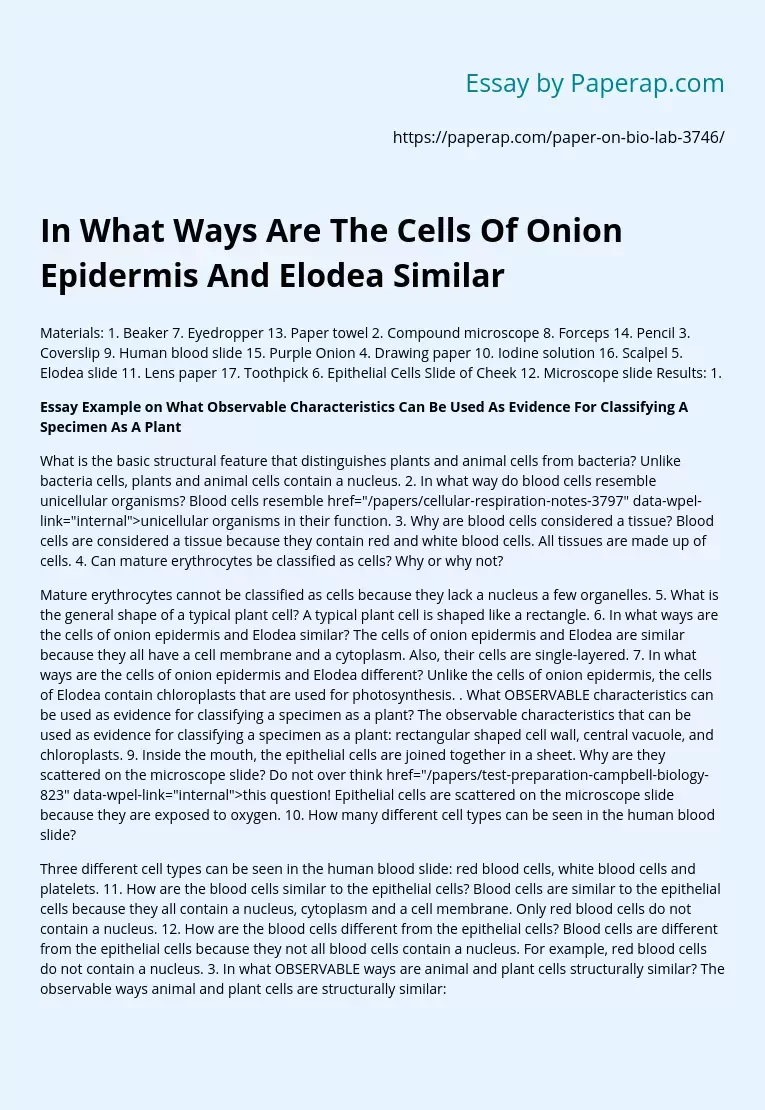In What Ways Are The Cells Of Onion Epidermis And Elodea Similar
Materials: 1. Beaker 7. Eyedropper 13. Paper towel 2. Compound microscope 8. Forceps 14. Pencil 3. Coverslip 9. Human blood slide 15. Purple Onion 4. Drawing paper 10. Iodine solution 16. Scalpel 5. Elodea slide 11. Lens paper 17. Toothpick 6. Epithelial Cells Slide of Cheek 12. Microscope slide Results: 1.
Essay Example on What Observable Characteristics Can Be Used As Evidence For Classifying A Specimen As A Plant
What is the basic structural feature that distinguishes plants and animal cells from bacteria? Unlike bacteria cells, plants and animal cells contain a nucleus. 2. In what way do blood cells resemble unicellular organisms? Blood cells resemble href=”/papers/cellular-respiration-notes-3797″ data-wpel-link=”internal”>unicellular organisms in their function.
3. Why are blood cells considered a tissue? Blood cells are considered a tissue because they contain red and white blood cells. All tissues are made up of cells. 4. Can mature erythrocytes be classified as cells? Why or why not?
Mature erythrocytes cannot be classified as cells because they lack a nucleus a few organelles. 5. What is the general shape of a typical plant cell? A typical plant cell is shaped like a rectangle.
6. In what ways are the cells of onion epidermis and Elodea similar? The cells of onion epidermis and Elodea are similar because they all have a cell membrane and a cytoplasm. Also, their cells are single-layered. 7. In what ways are the cells of onion epidermis and Elodea different? Unlike the cells of onion epidermis, the cells of Elodea contain chloroplasts that are used for photosynthesis. . What OBSERVABLE characteristics can be used as evidence for classifying a specimen as a plant? The observable characteristics that can be used as evidence for classifying a specimen as a plant: rectangular shaped cell wall, central vacuole, and chloroplasts.
9. Inside the mouth, the epithelial cells are joined together in a sheet. Why are they scattered on the microscope slide? Do not over think href=”/papers/test-preparation-campbell-biology-823″ data-wpel-link=”internal”>this question! Epithelial cells are scattered on the microscope slide because they are exposed to oxygen. 10. How many different cell types can be seen in the human blood slide?
Three different cell types can be seen in the human blood slide: red blood cells, white blood cells and platelets. 11. How are the blood cells similar to the epithelial cells? Blood cells are similar to the epithelial cells because they all contain a nucleus, cytoplasm and a cell membrane. Only red blood cells do not contain a nucleus. 12. How are the blood cells different from the epithelial cells? Blood cells are different from the epithelial cells because they not all blood cells contain a nucleus. For example, red blood cells do not contain a nucleus. 3. In what OBSERVABLE ways are animal and plant cells structurally similar? The observable ways animal and plant cells are structurally similar: plasma membranes and cytoplasm. 14. In what OBSERVABLE ways are animal and plant cells structurally different? Plant cells are structurally different then animal cells because they contain a cell wall, chloroplast, and a central vacuole. 15. Onions are classified as green plants. Where in the onion plant are the green cells located? Green cells are located at the root of onion plants.
In What Ways Are The Cells Of Onion Epidermis And Elodea Similar. (2019, Nov 27). Retrieved from https://paperap.com/paper-on-bio-lab-3746/

